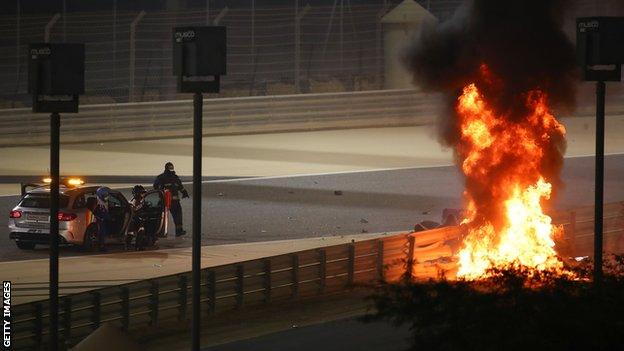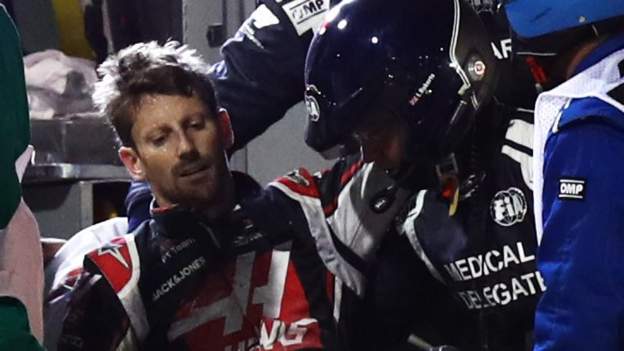
Romain Grosjean suffered an impact of 67G in his fiery crash at the Bahrain Grand Prix, the official report into the incident concludes.
Analysis by governing body the FIA has identified more than 20 areas in which safety can be improved.
These include changes to the cars, barriers, circuits, driver safety equipment and medical response.
FIA president Jean Todt said the report provided “important learnings that will drive our mission to improve safety”.
Grosjean’s crash was one of the most dramatic in many years, as his Haas car split the crash barrier, and was suspended in it on its side. The driver was trapped in the burning car for nearly 30 seconds before managing to wriggle out to safety. The Frenchman suffered burns to his hands, which have now healed sufficiently for him to begin racing in the US-based Indycar series.
It was the first time a car had caught fire so dramatically in a crash in a grand prix since 1989, and the first time a barrier had split in such a way since the 1970s.
While the impact force was higher than the FIA initially suggested in the immediate aftermath of the accident, at 67G compared to 53G, the actual impact speed turned out to be lower, at 119mph rather than 137mph.
The report said that the force of the impact caused the middle rail of the barrier to fail, and “significant deformation” of the upper and lower rails.
The fire was caused by fuel escaping as a result of the dislodging of the fuel hatch on the left-hand side of the chassis and the fact that the engine fuel supply connection was torn from the tank ‘safety bladder’.
And it concluded that the driver safety equipment, including helmet, head and neck safety device (Hans), survival cell, headrest and halo cockpit protection system had protected Grosjean and “managed the forced applied to the driver during the impact”.
It took just 11 seconds for the medical car to arrive on the scene, enabling FIA doctor Ian Roberts to instruct a marshal to direct a fire extinguisher at the cockpit, where he could see Grosjean trying to escape.
FIA Safety Director Adam Baker said: “Incidents involving fire of this scale are thankfully rare, so it is very important to learn what we can, including the interaction with the [car’s] high-voltage system.
“The efforts of those involved were heroic and have quite rightly been the subject of much praise. Following the approval of our findings by the World Motor Sport Council, we will integrate the actions into the ongoing work.”
Among the areas where changes will be made are:
•the geometry of the front of the car’s survival cell and additional load tests
•head restraints aimed at ensuring they do not impede driver egress
•Engine mounting and fuel cell installations
•Reviews of barrier design and positioning
•Reviews of the process for approving circuits
•Updating medical intervention equipment, including fire extinguishers
And there will be further research into a number of areas including warning systems, and improving existing barriers and fire equipment, as well as new barrier systems.
